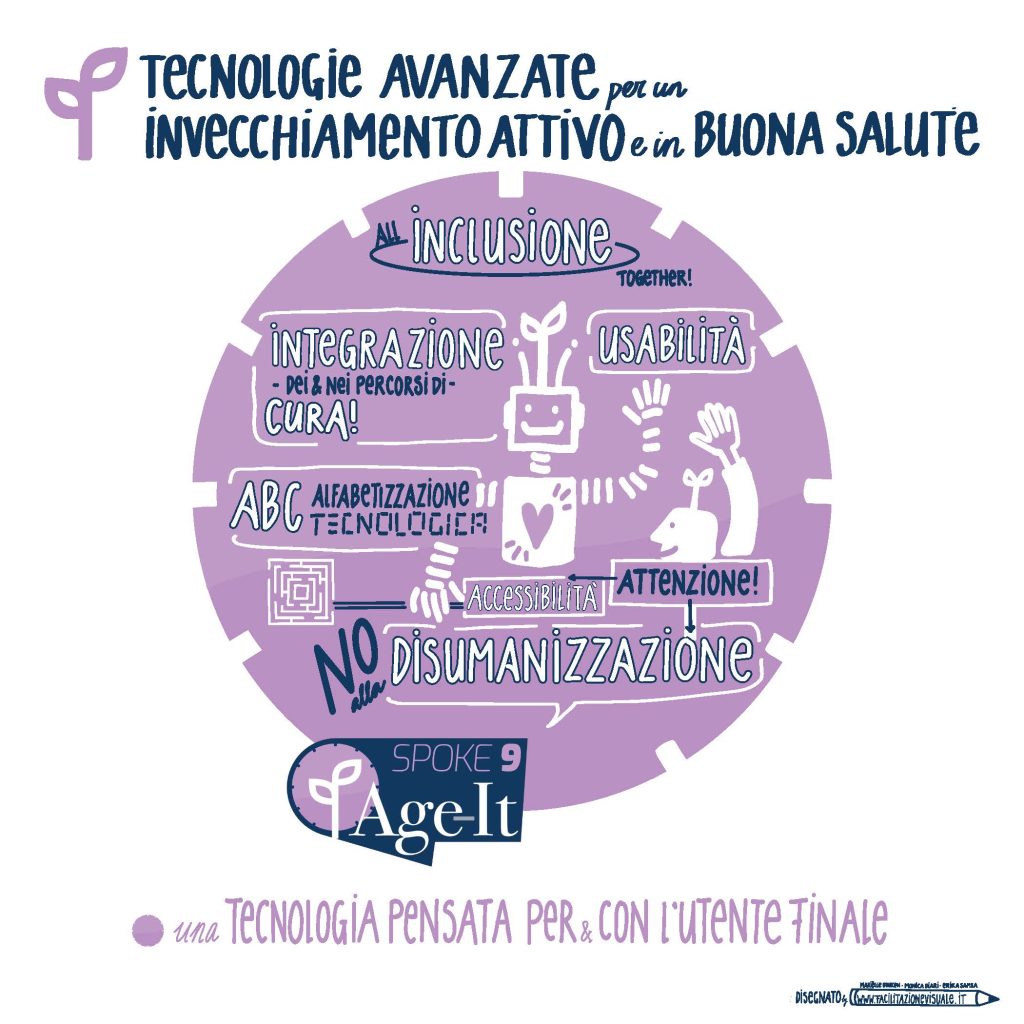
Advanced Gerontechnologies for active and healthy ageing
Leader: Filippo Cavallo, UNIFI
Co-Leader: Pietro Siciliano, CNR
Affiliati: UNIPD, SAPIENZA, UNICAL, UNICATT, INRCA, MUNICIPIA, HEALTHWARE, TECH4CARE
Spoke Themes
This Spoke addresses the study, design, development, test and validation of the scientific and technological feasibility and acceptability of advanced technologies for active and healthy ageing, focusing on novel solutions conceived for broad-ranging living environments, e.g., home, public and working spaces. It aims to respond to the need of breakthrough developments and technologies for fostering innovative and disruptive health and care paradigms, increasing quality of life in living environments and promoting prevention based on healthy lifestyles and older adults' empowerment. The spoke will focus on technologies that are still in the lowest TRL level positions.
Structure
Activities are structured in 4 technological WPs, aiming to investigate and enhance the maturity level of technology in human machine interfaces (WP2), assistive robotics (WP3), smart living environments (WP4) and systems for health monitoring and prevention (WP5). WP1 is conceived to supervise and harmonize all WPs with foundational research topics of ageing, such user centred design
Disciplines
Robotica, neurorobotica e intelligenza artificiale per la robotica, telecomunicazioni e sistemi complessi per l’elaborazione delle informazioni, ingegneria biomedica, biomeccatronica, biomedicina, design industriale e tecnologia architettonica, progettazione architettonica e urbana.

Work Packages
Prof. Tiziana Ferrante, SAPIENZA
WP1 will draw the guidelines for the design of physical and digital interfaces of aids, enabling technologies for the improvement of older adults’ quality of life. An interdisciplinary framework for the assessment and monitoring of living environments with technology integration jointly with the development of a health promoting building evaluation and monitoring system in healthcare primary care service will be developed. Finally, design support tools for assessment of the spatial and technological adaptability of housing to home health care will be implemented.
Prof. Filippo Cavallo, UNIFI
WP2 aims to enhance software and hardware that allow interaction processes and bridge capabilities between users and service/machines. WP2 will investigate, design, develop and test novel “social machines”, namely social robots, apps, VR/AR tools and devices that will be conceived and integrated to interact and communicate with humans by means of social behaviours and rules. WP2 will generate through “social machines” a number of digital biomarkers of interaction that could be used for early identification of motor and cognitive decline in frailty and dementia.
Prof. Emanuele Menegatti, UNIPD
WP3 aims to develop a new generation of robots to monitor, assist, and boost motor performance in older people. WP3 will design innovative symbiotic wearable robots to increase performance and prevent falls at home and workplace. We aim at developing: 1) new paradigms for robot perception of humans and of human control of robots (i.e., innovative sensors, advanced algorithms); 2) cutting-edge wearable robots for older humans’ empowering; 3) a seamless approach of human perception and support with wearable actuators and sensors.
Prof. Pietro Siciliano, CNR
WP4 aims: 1) to develop a new generation of sensing technologies with defined targets about performances, costs and usability; 2) to process data using AI to measure and predict well-being and support services for the quality of life of ageing people; 3) to implement new generation sensors and sensor networks integrated in the SLE, i.e., home, working environment, daily life activities and outdoor urban spaces.
Prof. Sandra Costanzo, UNICAL
WP5 will implement solutions to realize personal monitoring at home, reducing operator dependence, while guaranteeing security, reliability and action conformity. It will develop: 1) an ultra-portable echography system, with related processing algorithms with low computational cost; 2) a Time-Domain functional Near-Infrared Spectroscopy instrument optimized for non-invasive physiological monitoring purpose; 3) a local hub including an “age-friendly” interface to perform guided measurements of physiological parameters, designed and equipped with health-monitoring sensors.
Key Outputs
- Identification of guidelines for the design of technology interfaces for older adults.
- Prototypes for smart housing and optimization of living environments for ageing people.
- Identification from literature analysis of digital biomarkers of interaction that could be used for early identification of motor and cognitive decline in frailty and dementia.
- Toolkits with technical analysis on user/machine integration and problem solving on developing of digital biomarkers through cases and scenarios analyses.
- Toolkits for industries with case report analyses, market trends to implement sensing technologies at home, working environment and urban spaces.
- New technologies integrating robots and wearable devices.
- Prototypes of an ultrasound echography system tested in relevant environment.
- Prototype of a Near-Infrared Spectroscopy optimized for non-invasive physiological monitoring tested in relevant environment.
